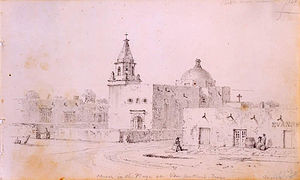(This is a slightly reworked piece I did for a local real estate blog, which alas seems to have gone dormant – enjoy! CH)
For much of the 19th century and into the early Twentieth, it was a popular San Antonio custom. Various of the public squares, notably Military Plaza and Market Square were the domain of the Chili Queens who established a custom of setting up tables and benches along the edges of the squares, in the early evening and selling chili-by-the-bowl to all comers. They would bring huge kettles of chili which they had made over their own home cook-fire during the day, and keep it warm through the evening and into the wee hours over an open fire. The chili vendors would entice customers to their own particular stands by hiring musicians to entertain diners. There are some splendid descriptions of how marvelous this would have appeared – lantern and starlight shining down on the tables, gleaming on glass soda bottles, while the scent of the chili and the mesquite smoke from the fires which kept it warm hung on the night air. (I used this scene several times in Lone Star Sons, and in Adelsverein – The Sowing.) During South Texas summers before the invention of air conditioning, this likely would have been about the most comfortable dining venue for working men, for those out for an evening of gambling and drinking in the various saloons … and in later decades, for those visiting from the North or the East, desirous of absorbing a little exotic local color.
Chili was a very local delicacy in those years. Texans took readily to a venison or beef stew highly spiced with local chili peppers (with or without beans, with or without tomatoes), especially in the borderlands. But it was also a seasonal dish – generally only served in the spring and summer when the fresh peppers ripened and were available in the market. Air-dried whole chilies were available, of course – but they just didn’t provide the same flavor-punch. There may have been many local gourmands who adored chili and wished to eat it year round, but only one of them did anything about it.This was a German-American, Willie Gebhardt, who got his start in food entrepreneurship by owning a beer-garden and restaurant in New Braunfels in the 1890s. It’s often said among the Irish that there was an Irishman at the start of any interesting cultural, technological or scientific effort, but in Texas in the late 19th century this role most usually fell to a German. Willie Gebhardt, like many other local cooks, developed his own special recipe for chili, and served it often in season – but on the side, he began experimenting with a means of preserving the essential chili pepper flavor. Eventually he hit upon a means of soaking ancho chili peppers, garlic, oregano and cumin in a water-alcohol mixture, then grinding it into a stiff paste, which was dried under low heat. When dried, it was further ground into a powder using a coffee-grinder, and packed in air-tight glass bottles. It was immediately popular; Willie Gebhardt took out a patent, calling it Gebhardt’s Eagle Brand Chili Powder. By the turn of the century, he had opened a factory – patenting a number of machines to expedite the manufacture of chili powder, which became and still is insanely popular. Eventually his factory, under the direction of a brother-in-law branched out into providing ready-made canned chili, and other staple Tex-Mex foods. Since this cuisine was largely unknown outside of the southwest, Gebhardt’s company published a cook-book instructing American cooks how to use chili powder – the first nationally-distributed cook-book on Mexican food. The original recipe for Eagle Brand Chili Powder is still available, supposedly unchanged, although the company was sold to Beatrice Foods following on the death of Willie Gebhardt in 1956. (It’s available on Amazon – so is a facsimile of the original Gebhardt’s Mexican cookbook.)


Recent Comments